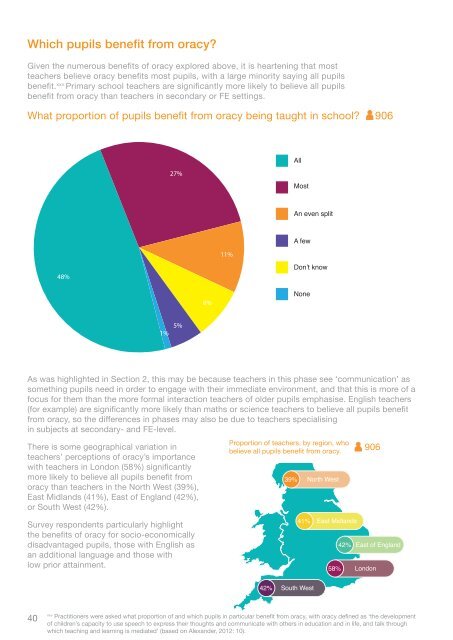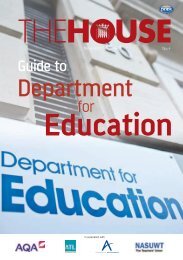Oracy
2fcBkno
2fcBkno
You also want an ePaper? Increase the reach of your titles
YUMPU automatically turns print PDFs into web optimized ePapers that Google loves.
Which pupils benefit from oracy?<br />
Given the numerous benefits of oracy explored above, it is heartening that most<br />
teachers believe oracy benefits most pupils, with a large minority saying all pupils<br />
benefit. xxv Primary school teachers are significantly more likely to believe all pupils<br />
benefit from oracy than teachers in secondary or FE settings.<br />
What proportion of pupils benefit from oracy being taught in school? 906<br />
All<br />
27%<br />
Most<br />
An even split<br />
A few<br />
11%<br />
48%<br />
Don’t know<br />
8%<br />
None<br />
1%<br />
5%<br />
As was highlighted in Section 2, this may be because teachers in this phase see ‘communication’ as<br />
something pupils need in order to engage with their immediate environment, and that this is more of a<br />
focus for them than the more formal interaction teachers of older pupils emphasise. English teachers<br />
(for example) are significantly more likely than maths or science teachers to believe all pupils benefit<br />
from oracy, so the differences in phases may also be due to teachers specialising<br />
in subjects at secondary- and FE-level.<br />
There is some geographical variation in<br />
teachers’ perceptions of oracy’s importance<br />
with teachers in London (58%) significantly<br />
more likely to believe all pupils benefit from<br />
oracy than teachers in the North West (39%),<br />
East Midlands (41%), East of England (42%),<br />
or South West (42%).<br />
Survey respondents particularly highlight<br />
the benefits of oracy for socio-economically<br />
disadvantaged pupils, those with English as<br />
an additional language and those with<br />
low prior attainment.<br />
Proportion of teachers, by region, who<br />
believe all pupils benefit from oracy.<br />
906<br />
39%<br />
41%<br />
North West<br />
East Midlands<br />
58%<br />
42%<br />
East of England<br />
London<br />
42%<br />
South West<br />
40<br />
xxv<br />
Practitioners were asked what proportion of and which pupils in particular benefit from oracy, with oracy defined as ‘the development<br />
of children’s capacity to use speech to express their thoughts and communicate with others in education and in life, and talk through<br />
which teaching and learning is mediated’ (based on Alexander, 2012: 10).




